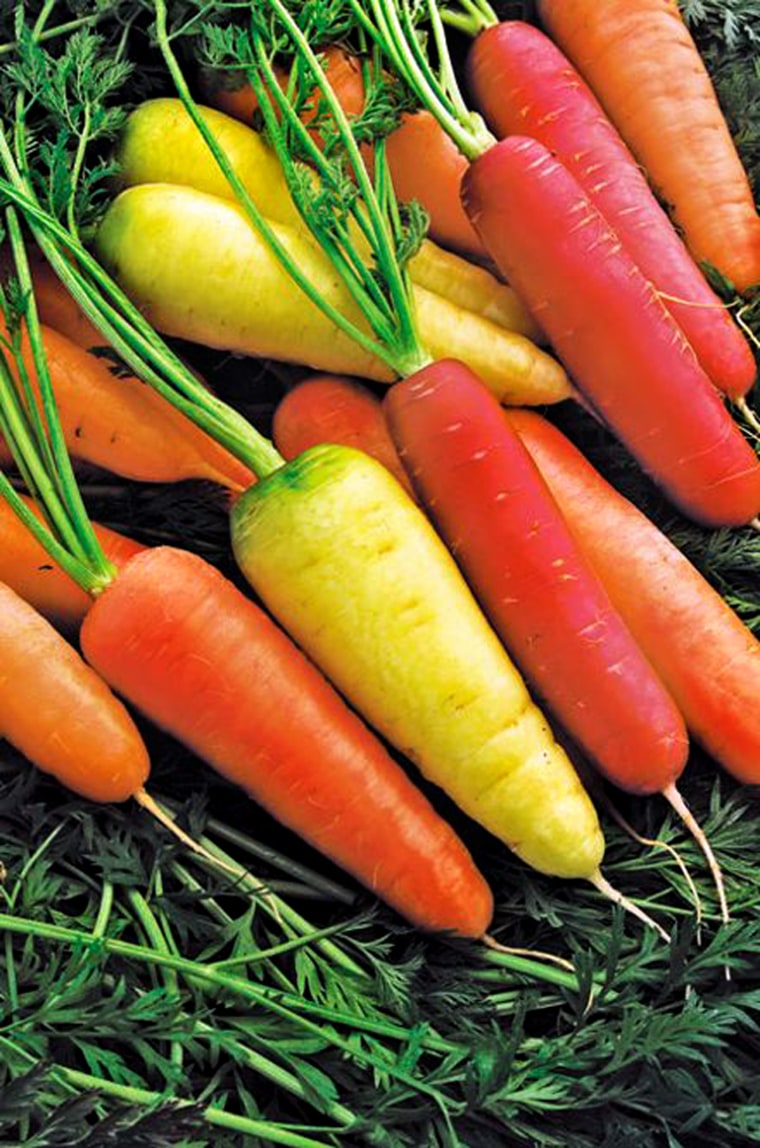Even for shoppers used to the riot of colorful fruits and veggies in a suburban grocery store, a walk through the produce aisle at the Harris Teeter supermarket in Mount Pleasant, S.C., is a feast for the eyes. There are exotic fruits like the kiwanos, with orange skin and white flesh that tastes of banana, watermelon, and cucumber. The spiky fruits are so odd that when they roll through checkout, even the cashiers can't always I.D. them. But also piled high on the shelves are cobs of corn with scarlet kernels that look like old-fashioned wild maize. These are a modern take on so-called "heirloom" varietals. The corn is custom-bred to have high levels of anthocyanin, an antioxidant usually found in red wine and blueberries. Down the way are some funny-looking artichokes — purple, thanks to a similar enrichment with anthocyanin.
Innovation is sweeping through the farm sector, bringing surprises that go beyond exotic fruits jet-shipped from the ends of the earth. In many cases it is consumers who are influencing produce breakthroughs, just as they forced agribusiness to take organic food seriously. Years ago seed companies courted farmers with new seed varieties that promised big harvests of veggies that could stay fresh for seemingly impossible lengths of time. Today's consumers are less interested in, say, rubbery tomatoes that last forever on a shelf, and more attracted to healthful produce that actually tastes good. Conventional hybridization, rather than genetic modification, is the name of the game. Here are some of the latest foods crafted to catch the eye and please the palate.
Growers
Some 70 percent of the nation's lettuce is produced in the Salinas Valley on the coast of California. Drive through the area, and you'll see lettuce fields for miles in every direction. Billboards celebrate the major producers, Dole Food Co. and Fresh Express, which have deep pockets and a lock on many supermarket shelves. It's the smaller growers, though, that are carving out new niches by devising specialty varieties.
Stephen Griffin, president of Misionero Vegetables in Salinas, knew the farm his father started would not survive selling bland heads of iceberg lettuce. So last year, along with its organic products and bagged salad mixes, Misionero started selling Lettuce Jammers, a cross between a romaine and an iceberg, created by Seminis.
The oversize boat-shaped leaf is extra durable, yet still crunchy and tasty, so it can be used like a natural tortilla wrap to hold hot foods such as chili or taco fixings.
Sometimes sold under names chosen by grocery stores, the lettuce has been picked up by Wal-Mart Stores Inc. and Loblaws Inc., a Canadian chain.
Another tack is to help shoppers select the freshest produce. The deep grooves in Syngenta's Dulcinea Farms Extra Sweet Tuscan Style Cantaloupe go from dark green to a golden cream color when ripe. "You can't make a buck if you don't have something distinctive," says Griffin.
Retailers
Designer products such as Colorful Harvest's carrots — also in red and yellow, thanks to added nutrients — are a hit with kids and moms and also help stores stand out. At Wild Oats Markets, Don Harris, the chain's top produce buyer, has worked with seedmakers and suppliers to create an exclusive organic broccoli with a wider, deeper head than usual. Other stores are quick to mimic. "Everyone catches up," says Harris, so Wild Oats is always on the lookout for something new.
Scientists
These new fruits and veggies aren't being cooked up using genetic engineering. Scientists employ older methods, such as crossbreeding different varieties of the same plant, but with a high-tech spin. To speed the time from lab to grocer, researchers probe the DNA of different varieties to identify traits such as color and taste and to find the fittest seeds to crossbreed. It's still largely a process of trial and error and can take 5 to 10 years to develop a salable product. Inspiration comes from all quarters. Scientists at seedmaker Seminis Inc., a unit of Monsanto Co., enhanced ordinary tomatoes by crossing them with a rock-hard, pea-size wild green tomato from the mountains of Peru that packs plenty of lycopene, an antioxidant that gives tomatoes their deep red color. At Cornell University, researchers mixed a naturally occurring orange-tinted cauliflower with a traditional white variety to make an orange cauliflower now sold by Seminis. The mellow hue appeals to chefs, and it also boasts 25 times more beta-carotene than its pale cousin.
Consumers are wary of genetically modified strains. In the U.S., the only major GM food crops are corn (used mostly for animal feed and corn syrup), soybeans, and canola. In the '90s, Calgene Inc. tried to sell Flavr Savr tomatoes, genetically altered to ripen slowly, giving it a longer shelf life. But flavor and quality are what it lacked, and it flopped. Still, the door isn't closed. Scientists might some day take a gene from a pepper and add nutrients to lettuce.
Seedmakers
Producers of seeds used to focus mainly on what farmers wanted to buy. These days, agri-giants such as Switzerland-based Syngenta and Monsanto's Seminis unit also seek input from grocery chains and shoppers. The process can be a tough balancing act. Retailers such as Whole Foods Market Inc. want eye-grabbing items to lure shoppers. But the big distributors that supply fast-food chains and packaged-food makers put a higher value on processability. Seminis has floated the idea of a cylinder-shaped tomato that could help fast-food chains reduce waste from slicing.
Consumers are invited to weigh in. Syngenta grows new crops and regularly convenes consumer panels to harvest preferences directly from those who fill the shopping cart. Syngenta's PureHeart watermelon is the result of trials showing that consumers want sweeter, smaller melons. The PureHeart weighs five to seven pounds — a third as much as regular watermelon.
